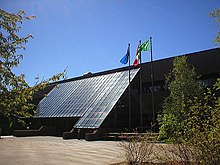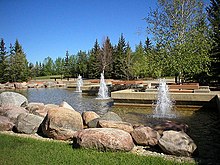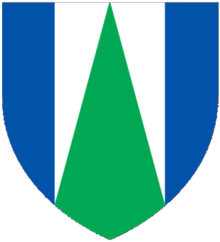|
Athabasca University
 Athabasca University (AU) is a Canadian public university that primarily operates through online distance education. Founded in 1970, it is one of four comprehensive academic and research universities in Alberta,[5] and was the first Canadian university to specialize in distance education.[6] OriginsAthabasca University was created by the Alberta government in 1970 as part of an expansion of higher education to cope with rising enrolment at the time. In the late 1960s, the University of Alberta (U of A) had long been established, the University of Calgary was created through new legislation, and an Order in Council had created the University of Lethbridge.[7] In 1967, the Manning government announced its intention to establish a fourth public university, but this would be delayed by three years as the government considered different proposals. The U of A wanted to expand rather than see another university open in Edmonton to compete with it. One proposal favoured establishing a Christian university instead of a secular one. Another early suggestion was an "Alberta academy" that would take credits students had earned at multiple universities, evaluate them for transfer, and perhaps award degrees. A Department of Education ad hoc group favoured the establishment of a fourth public university.[7] A group of U of A graduates including Preston Manning influenced the development of an independent fourth university. In 1970, Grant MacEwan, then the Lieutenant Governor of Alberta, established AU by an Order in Council. The name for the new university was a challenge, as it was not desired to associate the new university with a city (Edmonton) that already had a university (the U of A). Athabasca Hall, a student residence at the U of A, was scheduled for demolition, so the name was appropriated for the new Athabasca University.[7] In 1984, AU moved its main campus in Edmonton 145 kilometres (90 miles) north to Athabasca. The main campus remains in Athabasca, and there are satellite locations in Calgary, Edmonton and St. Albert. In 1994, AU's Centre for Innovative Management introduced the world's first online MBA program.[8] The program had 65 students in its first year, and to date there have been almost 4,000 graduates from the online MBA program.[9] Under the leadership of university president Dominique Abrioux (1995–2005), Athabasca expanded programs in all faculties, including graduate studies, with a new MA in Integrated Studies called MA-IS. Mandate The initial mandate for Athabasca University dictated that AU be primarily undergraduate in scope. Creating new procedures for curriculum development was also part of the mandate. AU's mandate was later revised to include graduate studies as well, and the university has offered graduate programs and courses since 1994. First president and early yearsIn April 1971, Timothy C. Byrne was appointed the first president of Athabasca University, and he assumed office in June that year.[7] The initial governing authority of the university had eight members as well as a broad range of powers to set up the new university. On 2–3 July 1970, they met for the first time, and Carl W. Clement was the first chair. It was expected by the government of the day that AU would have 10,000 students by 1979. 1 September 1973, was set as the target date to open.[7] The AU administration chose the University of California, Santa Cruz, as its model, deciding that individual colleges should serve as the basic planning units for the new university, which would be organized as a federation of colleges.[7] Each of the colleges was to have 650 students with corresponding lecture and office space. The learning approach would have students in small tutorials instead of large lectures. Research within the new university was to be limited to a specified region around the city of Edmonton. One criticism was that the university was trying to do too much.[7] The government of Peter Lougheed in 1971 brought changes including a cabinet portfolio specifically for post-secondary education. The newly elected Conservative government was opposed to building a new university in Edmonton, but architectural plans were permitted to continue. A proposal was made to the government to test the new model for three to five years, and if it succeeded, AU would become a fully independent university. This happened under chair Merrill Wolfe. The proposal was accepted by the government.[7] In the summer of 1972, the new deputy minister of Alberta Advanced Education stated there was a demand for lifelong continuing education. There was also a need for an "Alberta academy" that would evaluate university courses taken at multiple institutions and award degrees based on its evaluations. Meanwhile, AU also proposed to serve part-time students and made the case that this would not affect the traditional universities already established in Alberta or the new approach of AU. An open-door academic policy removing most traditional university admission requirements was part of AU's proposal.[7] In 1972, a new Order in Council was issued to include only a new pilot project for distance education.[7] Piloting distance educationTrial and error characterized the pilot period, as there was no similar model to follow for the mandate Athabasca University was given. In 1973, AU began to advertise for students to help with course development. World Ecology was the first course and the core of the pilot project. In-house production of the learning packages for courses was important to the staff, so the university developed its own printing process.[7]
In 1975, plans came together to reach out to students through field services tutors and regional learning resource centres. In 1976, the first part-time telephone tutors were appointed, 24 in total. The tutor role was to facilitate learning, not to teach the course. Tutors were assigned blocks of between 20 and 40 students each, and AU provided toll-free phone numbers that students used for contacting the tutors. All tutors were (and are still) required to have at least a master's degree.[7] An early test project for a learning resource centre had books and tapes relevant to the courses available at branches of public libraries throughout Alberta. Although the libraries were keen on the idea, students preferred to remain in their homes to learn. By 1975, the median age was between 35 and 40, and there were 725 students. A minority of students had only completed Grade 9.[7]
In 1975 at the end of the pilot project, an agency was appointed to evaluate its success. A recommendation was made to the Alberta government that the university be made a permanent member of the province's university system. It was also to remain an open university. Under the chairmanship of Edward Checkland, the university gained permanency.[7] In 1976, Sam Smith took over as president, and the university's permanency was established through an act of the Legislature of Alberta.[7] Early collaborationsThe first collaboration the university embarked on was with Keyano College, which eventually led to the opening of a regional learning office in Fort McMurray, Alberta. (This regional office would later close.) In 1976, North Island College took on the challenge of delivering many of AU's courses on its many campuses.[7]
In 1985, AU reached an agreement with the Correctional Service of Canada for the payment of tuition and program delivery fees for federal inmates taking courses through the university.[7] Modern partnerships and collaborationsThe university maintains more than 350 collaborative agreements with other Canadian and international educational institutions, with professional associations, with businesses, and with Indigenous institutions and communities.[10] Through Athabasca University's partnerships with other post-secondary institutions, students have options. For example, they can add an Athabasca University course to their program at a partner institution, take classroom versions of Athabasca University courses at a partner institution or enrol in an Athabasca programs while studying at or working for a partner institution.[11] Through established transfer agreements, Athabasca University also recognizes previous education that obtained through colleges, technical institutes, or professional organizations. Block credit transfer arrangements have been established with numerous educational providers across Canada, granting program graduates a specified number of credits toward a particular degree.[12] A range of academic partnerships are in place, including a recent announcement in early 2019 with Lakeland College.[13] Amazon Web ServicesAthabasca University is the first Canadian post-secondary institution to enter into a formal collaboration with Amazon Web Services, Inc. (AWS).[14] This collaboration modernizes AU's IT infrastructure and the two organizations will also be designing, implementing, and managing cloud education programs, artificial intelligence and machine learning initiatives, and research-based applications for the education sector.[15] The partnership speaks to the five-year digital transformation of Athabasca University, as set out by the university's strategic plans – Imagine: Transforming lives, transforming communities[16] and RISE: Athabasca University's Digital Transformation, Our 5 Year IT Strategy.[17] Canadian Football League Players' Association (CFLPA)In June 2014, Athabasca University formally partnered with the CFLPA as the official education provider for their players – both past and present. Western Hockey League (WHL)Since 2009, the WHL and Athabasca University have partnered, offering fully accredited university courses to any WHL player interested in pursuing post-secondary studies while playing in the WHL. For the 2018/2019 hockey season, over 75 players have been taking courses through Athabasca University.[18] Professional Hockey Players' Association (PHPA)Partnering with the PHPA, members of the association have access to online courses that they can complete through Athabasca University.[19] Blue Seal ProgramThe Achievement in Business Competencies Program, also known as the Blue Seal Program, gives Alberta-certified trade and occupational certificate holders the opportunity to earn a business credential that is recognized by employers. A Blue Seal illustrates they have the skills needed to succeed in business.[20] Education delivery models The majority of Athabasca University's courses are taught through online distance education, but some courses or components of courses are taught in-person, face to face. The major education delivery models at AU are as follows:
Centre for Distance EducationIn addition to delivering courses and programs primarily through online distance education, Athabasca University has a Centre for Distance Education (CDE).[22] Since 2019, the CDE has existed in name only, and its staff and programs are now part of the Faculty of Humanities & Social Sciences (FHSS). The former CDE, led by a core faculty and supported by additional sessional instructors, offered graduate-level courses and programs that taught other educators how to develop, design and deliver online education. The CDE was home to North America's first online Doctor of Education in Distance Education, and it also offered a Master of Education in Distance Education and post-baccalaureate certificates and diplomas in distance education technology, instructional design, and technology-based learning. These programs and associated teaching methods continue to thrive in the FHSS. Distance education researchAU also sponsors the publication of the International Review of Research in Open and Distance Learning, which is listed in the Social Sciences Citation Index and is a well-known and frequently cited scholarly journal in the field of distance and open education.[23] AccreditationAthabasca University reports to the government through the Minister of Advanced Education and is publicly funded through the Province of Alberta. The university's governing council is authorized to grant degrees through the Post-Secondary Learning Act along with governing its own affairs. Members of the governing council are appointed by the Lieutenant Governor in council.[24] Under the Post-Secondary Learning Act,[25] Athabasca University is considered a "Comprehensive Academic and Research University" (CARUs).[26] CARUs offer a range of academic and professional programs, which generally lead to undergraduate and graduate level credentials and have a strong research focus.[26] The university is accredited with the United States by the Commission on Higher Education of the Middle States Commission on Higher Education.[27] Select memberships
AcademicsAU is Canada's only exclusively open university, and Maclean's Magazine called it Canada's fastest growing university.[30] 50% of AU's students are between the ages of 25 and 44, and admissions are year-round. AU hosts four Canada Research Chairs, with an additional one allocated in 2019.[31] ResearchAU has five faculties: College of Business, College of Health Disciplines, College of Humanities and Social Sciences, College of Science and Technology and College of Graduate Studies.[32] AU spends over $2 million per year on research.[33] The university has four Canada Research Chairs, one NSERC/Xerox/Markin/ICORE Research Chair and one of three UNESCO/COL Chairs.[34] The Athabasca University Research Centre is the primary centre at the university, along with the Technology Enhanced Knowledge Research Institute and the Centre for World Indigenous Knowledge and Research. AU is also a participating member of the WestGrid Research Network. Notable faculty
Scholarships and bursariesThe Government of Canada sponsors an Aboriginal Bursaries Search Tool that lists over 680 scholarships, bursaries, and other incentives offered by governments, universities, and industry to support Aboriginal post-secondary participation. Athabasca University bursaries for Aboriginal, First Nations and Métis students include: Alberta Historical Resources Foundation; Syncrude Canada Ltd./Athabasca University Aboriginal Scholarship; Frank and Agnes Cardinal Neheyiwak Bursary; Harold Cardinal Essay Prize for Aboriginal Students; Canative Scholarship for Métis Students; AU President's Scholarship for a Blue Quills Student; First Peoples Technology Bursary[35] In addition, people with disabilities and International students have access to these bursaries and scholarships. Notable peopleSome notable people have studied through Athabasca University, including Alberta politician Debby Carlson,[36] Olympic bobsleigh racer Christian Farstad,[37] former Alberta Premier Ralph Klein, professional hockey player Alyn McCauley,[38] and cross-country skier Milaine Thériault.[39] AU serves over 38,000 students (over 7,900 full-load equivalents) and offers over 900 courses in more than 50 undergraduate and graduate programs in a range of arts, science and professional disciplines.[40] ControversyIn 2012, it was revealed that Athabasca University was among institutions of higher education involved in illegal donations to the provincial Progressive Conservative party of Alberta. The university spent $10,675 on Conservative fundraising events, including golf tournaments and dinners.[41] The university president retired early, and an interim president, Peter MacKinnon, was appointed by the university governing council. Coates ReportFacing financial pressures in 2015, Athabasca University underwent an independent third-party review to report to ascertain long-term solutions.[42] The report[43] found that there was a significant student demand for flexible, online post-secondary options, but that Athabasca University needed a clear and shared vision for the future.[44] Looking forwardLooking to the future and guided by a new president, Neil Fassina, Athabasca University charted a renewed course. Building off recommendations from the Coates Report, Imagine: Transforming Lives, Transforming Communities[45] was a strategic plan forward, built out of extensive collaboration with the entire Athabasca University community and acted as a roadmap with priorities to guide them on the path forward. Imagine: Transforming Lives, Transforming CommunitiesImagine: Transforming Lives, Transforming Communities[46] is a strategic plan that charted the path forward for Athabasca University crystallized the university's mission and mandate. Important priorities were enacted, including a partnership with Amazon Web Services to transform and update its Information Technology infrastructure.[47][48] A range of educational partnerships and collaborations also increased opportunities for learners to have barriers moved for access to university-level education, from Bow Valley College[49] to Aspen View Public Schools and Northern Lakes College.[50] Student representationUndergraduate studentsUndergraduate students at Athabasca University are represented by the Athabasca University Students' Union. The AUSU head office is in AU Edmonton, though the students' council may have elected members from any area where AU students reside. AUSU was officially incorporated as of 16 July 1992, and was formalized as a registered Alberta society until students' unions in Alberta were granted recognition under the Post-Secondary Learning Act. On 13 September 2004 the Lieutenant Governor of Alberta approved an order in council establishing "The Students' Association of Athabasca University". AUSU offers services to its members including but not limited to: an optional health & dental plan student awards, a free subscription to LinkedIn Learning, student advocacy, and Athabasca University course evaluations.[51] Student media at Athabasca University is provided by the official publication The Voice Magazine. Previously published on paper, the magazine since 2001 is published exclusively online in HTML and PDF format.[52] Graduate studentsVisiting and program students at the graduate level are represented by the Athabasca University Graduate Students' Association.[53] The organization was founded in 2010, and approved by the Alberta Advanced Education. Arms
See alsoReferences
Further reading
External linksWikinews has related news:
Wikimedia Commons has media related to Athabasca University. |
||||||||||||||||||||||||||||||||||||







